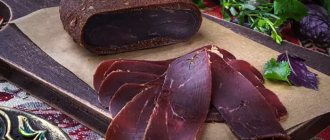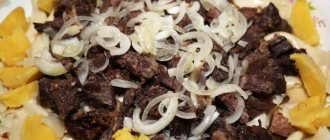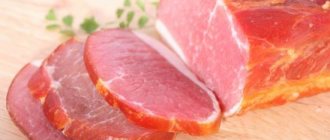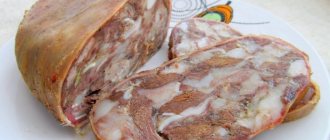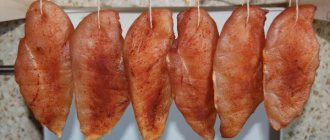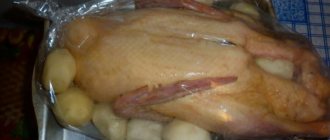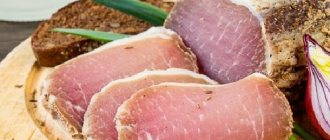Meat has been present in the human diet since ancient times, being one of its main components. In order to preserve meat in conditions when there was no trace of refrigerators, cooks tried their best: smoked, dried, marinated in spices, dried - in a word, experimented. And - a funny curiosity! — as a result, it is meat products prepared “the old fashioned way” that today have gained a reputation as the main delicacies that can become a decoration for any holiday table.
One of these delicacies is basturma. Dried beef tenderloin, seasoned with aromatic spices, is famous for its piquant taste and unique aroma.
Historical reference
The historical homeland of basturma is considered to be the states located on the territory of the former Ottoman Empire. This name is first mentioned in manuscripts dating back to 95 BC.
Content:
- Historical reference
- Cooking technology
- How to choose a quality delicacy
- How to store it correctly
- Chemical composition, calorie content and beneficial properties
- Use in cooking
- Harm and contraindications
- Interesting Facts
There are several versions about how this dish appeared. The first of them is the simplest. It says that the court cooks of the Armenian king Tigran Mets (Tigran the Great) were the first to prepare basturma. The king, whose reign was marked by numerous military campaigns and campaigns, instructed the cooks to come up with a way that would help preserve meat for a long time, since the soldiers needed something to eat, and they could not always count on a successful hunt. As a result, a method was invented for drying meat, previously rubbed with a mixture of spices.
The second theory says that during a military clash that occurred in one of the campaigns, the bags in which the meat was transported were torn, and the salt and spices that were in a nearby container spilled onto the “strategic reserve.” The warriors did not dare to throw away the meat; they simply cleaned it of salt and seasonings to the best of their ability and put it in saddle bags. As a result, some time later it was discovered that the meat was edible.
The third version seems the most exotic, but also extremely unappetizing. However, historians are inclined to believe that it is she who is closest to the truth. So, it says that the word “basturma” comes from the Turkic word “basdirma” - compressed horse meat. According to this theory, during their campaigns, Genghis Khan’s warriors, in order not to carry huge convoys with provisions, carried horse meat with them, cutting it into pieces and tying it directly under the horse’s saddle. As a result, the meat became saturated with horse sweat containing salt, and under the influence of the rider’s weight, excess liquid came out of it. The result was a very strange dish, the main advantage of which was its long shelf life.
Merchants also adopted this method of transporting meat. In the Middle Ages, dried meat became the basis of the diet of sailors. Of course, they prepared it in a way that was more acceptable from a modern point of view - rolled it in salt and spices, placed it under a press, and then dried it.
Basturma - Wikipedia (with comments)
Material from Wikipedia - the free encyclopedia
K:Wikipedia:Articles without sources (type: not specified)
Basturma
(Azerbian: Basdırma, Armenian: Բաստուրմա, Turkish: Pastırma) is a dried beef tenderloin, a dish in the cuisines of countries located in the territory of the former Ottoman Empire.
Fresh tenderloin is salted, then placed under a press (rubbed with salt) to remove excess moisture and give it a shape convenient for slicing.
Then they are transferred to a mixture of garlic, ground red and black pepper seeds, and blue fenugreek (chamana), which has the consistency of batter.
The resulting pieces are hung out to dry.
Not to be confused with pastrami - smoked marinated meat.
The common feature of the technology is aging under pressure.
- Basturma or Pastrama from Armenia 1.JPG
Armenian basturma
- Pastirma1.jpg
Turkish basturma
Write a review about the article “Basturma”
Links
Excerpt characterizing Basturm
– What’s burning? – Natasha asked. - Oh, yes, Moscow. And as if in order not to offend Sonya by refusing and to get rid of her, she moved her head to the window, looked so that, obviously, she could not see anything, and again sat down in her previous position. -Have you not seen it? “No, really, I saw it,” she said in a voice pleading for calm. Both the Countess and Sonya understood that Moscow, the fire of Moscow, whatever it was, of course, could not matter to Natasha. The Count again went behind the partition and lay down. The Countess approached Natasha, touched her head with her inverted hand, as she did when her daughter was sick, then touched her forehead with her lips, as if to find out if there was a fever, and kissed her. -You're cold. You're shaking all over. You should go to bed,” she said. - Go to bed? Yes, okay, I'll go to bed. “I’ll go to bed now,” Natasha said. Since Natasha was told this morning that Prince Andrei was seriously wounded and was going with them, only in the first minute she asked a lot about where? How? Is he dangerously injured? and is she allowed to see him? But after she was told that she could not see him, that he was seriously wounded, but that his life was not in danger, she, obviously, did not believe what she was told, but was convinced that no matter how much she said, she would be answer the same thing, stopped asking and talking. All the way, with big eyes, which the countess knew so well and whose expression the countess was so afraid of, Natasha sat motionless in the corner of the carriage and now sat in the same way on the bench on which she sat down. She was thinking about something, something she was deciding or had already decided in her mind now - the countess knew this, but what it was, she did not know, and this frightened and tormented her.
Cooking technology
Classic basturma is made exclusively from beef, although there are variations of this dish made from chicken, lamb, and pork. Only meat from young animals is used. Tenderloin, fillet, and rump are suitable for preparing beef basturma.
The first stage of preparing basturma is cutting the meat into long and thin plates, the thickness of which should not exceed three centimeters. These plates, having previously been rubbed on all sides with salt (usually coarse salt is used), are placed in a wooden container, also on a layer of salt. A few days later, the meat begins to release juice, after which it must be kept in this brine for another three weeks.
After this, you should soak the meat in running water for several days. As a result, it becomes softer, and excess salt disappears. However, for now this product is corned beef, not basturma. To turn the meat into a delicacy, it should be rubbed with spices. Most often, a mixture is prepared from blue fenugreek, crushed garlic, red and black pepper, suneli hops and other seasonings. The result is a mixture with a consistency reminiscent of liquid dough, which is used to coat the pieces of meat. After this, each of the pieces, tied with twine, is hung in a place protected from direct sunlight with good air circulation. The basturma will have to spend two to three weeks in this state.
Homemade basturma
For our ancestors, storing and preparing meat was a challenge, and drying as a method of preserving meat was used in ancient civilizations long before refrigeration.
Our ancestors stumbled upon something magical: salt preserves meat by drawing out moisture; slows down spoilage (meat acquires new textural properties that do not promote bacterial growth); The flavor of the meat is concentrated.
Thanks to this invention, people could live where it was impossible to grow anything; dry-cured meat sustained them during long, cold winters and nourished them during long sea and land journeys. This is how conquerors and discoverers ate as they traveled the world.
Food saltpeter
Then, probably in the 1600s, someone discovered that a mixture of salt and saltpeter rubbed into meat worked better. No one, of course, knew then that the potassium nitrate in saltpeter kills the deadly bacterium Clostridium botulinum, which causes botulism. It has also been observed that potassium nitrate maintains the pink color of meat.
Today, hardly anyone uses saltpeter, including you. Specially prepared mixtures of table salt, sodium nitrite, and sodium nitrate are used by commercial manufacturers and home cooks. This mixture keeps bacon, hot dogs, ham and corned beef pink and with a distinctive strong meaty aroma and intense flavor.
The refrigerator and the modern food industry with its cans and plastic bags have made the average home cook afraid of this simple and healthy food. But dried meat has a striking difference from meat stored in the freezer, where it slowly degrades over time.
Basturma
Basturma is one of the most popular and well-known appetizers for our holiday table. The entire process of making this delicious jerky in our recipe is very simple and takes about 8 to 10 days.
The most important thing is that the meat must be fresh, never frozen, preferably sirloin steak, which guarantees that the basturma will be tender, tasty, melt in the mouth and easy to bite.
Recipe for making dry-cured meat (basturma) at home.
The smell is amazing: salty, with high decibel aromas of fenugreek, cumin and cracked pepper.
We hope that you will prepare basturma according to this recipe and enjoy it!
Ingredients:
- This recipe is for 1300 -1400 gr. beef fillet, make sure the meat is fresh and has never been frozen.
- A pack of coarse salt.
Preparation of paste for coating:
In a food processor, blend until smooth:
- 1 medium head of garlic,
- ¼ glass of water
- 2 tablespoons red pepper paste.
Place all other ingredients in a bowl, mix thoroughly and gradually add the remaining water.
Add the spice mixture to the processor and process until smooth. The paste should be quite thick and viscous.
Step 1
We start by preparing the meat: wash the meat, cut and remove all excess fat and films, cut off the edges that you do not need.
Step 2
Using a pointed skewer or a thick awl, make several holes in the pieces of meat.
Step 3
Sprinkle the bottom of a baking sheet or tray generously with salt and place the meat there. Sprinkle the meat with salt; it should be completely covered with salt. Cover the baking sheet with a lid or plastic wrap and place in the refrigerator for 2 days. After some time, check to see if there are areas that have absorbed all the salt and, if there are, cover them with salt.
Step 4
Rinse thoroughly, then pat dry the meat very well. Wrap in several layers of paper towel and place under heavy pressure for 1 day. During this time, constantly check the moisture of the paper towel, and if it gets wet, wrap the meat in a dry paper towel.
Step 5
Remove the towels from the meat and hang it for 2-3 days in a room out of direct sunlight. You can use metal hooks or simple twine to hang the meat.
Step 6
Trim and discard any overly dried out parts of the meat. Generously spread the spice mixture over the entire surface of the meat. Hang for another 3-4 days.
Basturma is ready. Slice thinly with a sharp knife and enjoy!
Store the finished basturma in the refrigerator.
Source: https://pryanost33.ru/blog/2018/03/05/domashnyaya-basturma/
How to choose a quality delicacy
High-quality basturma, prepared in strict accordance with all the rules, is an incredibly tasty delicacy, but at the same time very expensive. To make the production process less expensive, many unscrupulous manufacturers are trying to save money. Most often, they use low quality ingredients for this purpose.
To ensure that the purchased product does not disappoint you, you should approach the choice of delicacy responsibly, taking into account several important rules:
- Buy basturma exclusively from trusted sellers. Carefully inspect the vacuum packaging - there should be no punctures, cuts or scratches.
- Study the composition. Ideally, only three types of ingredients should be present there: spices, salt and beef. If the list contains flavors, dyes, flavor enhancers and other dubious substances, then it is better to refuse to purchase such dried beef.
- Inspect the color of the basturma. The meat should not have a bright red tint, since this color indicates the use of dyes. Properly prepared natural basturma should be red-brown, not too bright. There should be no colored inclusions on the cut.
- The consistency of high-quality basturma is elastic. The meat springs back slightly when pressed. If, after you press on the meat, a hole forms in it, it is better to refuse the purchase.
- The spice coating “sits” on high-quality beef jerky like a glove - it does not crumble or fall off in pieces.
- The fresh product has a characteristic spicy odor. If you feel some mustiness, it means that the cooking technology and storage rules were violated.
Description
The seasoning for basturma is called chaman. This is due to the fact that the basis is the plant of the same name. It is also called shamballa, fenugreek, fenugreek. The spices contain the seeds and herbs of this plant. Additionally, other herbs are added. Depending on the ingredients used, it can be sandy to reddish brown in color.
Seasoning for basturma has a composition that has a positive effect on human health:
- accelerates metabolic processes;
- helps increase the amount of milk during lactation;
- has an anti-inflammatory effect;
- strengthens the immune system;
- improves hair condition;
- tones;
- helps with problems with sexual function;
- nourishes the cells of the bone marrow and nervous system;
- improves the functioning of the gastrointestinal tract;
- is a natural aphrodisiac;
- relieves pain.
How to store it correctly
Basturma is a product that is extremely finicky to store. It does not tolerate high temperatures, and therefore it must be stored exclusively in a cool place. At the same time, this delicacy cannot be placed in the refrigerator either, because this will negatively affect its aroma and taste.
It is not recommended to store basturma in plastic containers or plastic bags. It is best to use a linen bag, and store it suspended, in a place with good air circulation.
If you still have to put the basturma in the refrigerator, then you should first wrap it in cling film so that it does not absorb foreign odors. The meat should be consumed within the next few days.
Shelf life varies from two to six months. It depends on what kind of meat was used to prepare the delicacy, as well as on the amount of spices and salt.
What seasonings are needed for basturma?
26.03.2019
Salted meat with spices that is dried in the open air is basturma. Seasoning for basturma adds flavor to the dish and makes it a delicious delicacy.
This kind of meat can be stored for a very long time. Salt, by drawing out moisture, helps preserve the product. Dried meat fibers become thin, brittle and very tasty.
Beef seasoning
According to traditional recipes, beef is used for cooking. A dish made from pork or poultry is no less tasty.
Important! Chaman is a spicy plant from the legume family. Other spices are added to the seasoning that receives this name.
It is not difficult to prepare the dish at home. Although the process is long and requires patience. In order for the beef to absorb the flavor of the seasonings, you need to choose the right cut of meat and prepare it correctly. Required:
- beef tenderloin – 1 kg;
- coarse table salt - a pack.
Important! Veal is not suitable for cooking. The best option is a piece of red meat approximately 5-7 cm thick.
Spices for beef basturma:
- half a glass of ground chaman;
- the same amount of ground paprika;
- a third of a teaspoon of red hot pepper;
- a teaspoon of ground black pepper;
- the same amount of cumin seeds (a little more is acceptable);
- clean water - a tea cup.
Meat preparation
- A well-washed piece of beef is freed from fat and films.
- Using a sharp skewer (you can use a thick awl), punctures are made in the beef.
- A layer of salt about a centimeter thick is poured into the prepared tray.
- The cutting is laid out on it.
It is sprinkled with a thick layer of salt on top. - The dishes are covered with a lid or cling film and placed in the refrigerator.
- Exposure time – 48 hours.
Important! The process must be monitored.
If it is noticed that the salt has been completely absorbed, then the area is sprinkled with salt again.
After two days, the salt-soaked beef is removed from the tray and washed with running water. Then the slice must be drained, wrapped in a paper towel and left in the cold under pressure. Exposure time – 24 hours. If the napkins become wet, they must be replaced with dry ones.
The final stage
After a day, the tenderloin begins to dry. The optimal temperature is about ten degrees. The room should be dark with good ventilation.
The piece of meat is hung on hooks or regular twine and left for 3-4 days. Next begins the most important stage, which turns a piece of salted, dried meat into a delicacy. This is how spices for basturma make it.
All ingredients for preparing the paste are mixed, gradually adding water. Important! You may need a little less water. The main thing is that the paste is thick.
The beef is generously coated with a thick layer of the prepared mixture. The semi-finished product is hung again for 3-4 days in the same room. The aromatic snack is ready. It can be stored for a long time. Preferably in the refrigerator.
Seasonings for beef basturma may include other ingredients:
- khmeli-suneli;
- crushed garlic, coriander;
- ground juniper fruits;
- cloves
Seasoning for pork
It is better to choose lean pork for cooking. A piece of tenderloin must be carefully trimmed from fat inclusions. Fat gives jerky its toughness. Necessary:
- lean slice of pork tenderloin – 1 kg;
- salt and sugar 7 tablespoons each;
- a tablespoon of the main shambhala seasoning;
- a teaspoon each of ground black and red pepper;
- mustard seed, cumin, dried garlic, same amount, water.
Preparation:
- The prepared slice of tenderloin is pierced in several places and rubbed with a mixture of salt and sugar, covered with film and placed in the refrigerator for 2-3 days.
- Pork is a juicy meat, so periodically drain the juices.
- Then the piece is taken out, dried with napkins, placed again in the container. The meat should be covered with gauze and left under pressure for 2-3 days.
- The slice will become flat and harden. If more juice comes out, drain again.
- A thick paste is prepared from a mixture of spices and water. It is applied to the piece and swaddled with gauze in one or two layers.
- In this form, a piece of pork is hung on twine (hooks or thin rope) and dried for at least two weeks. Basturma is stored in the refrigerator.
Seasoning for poultry
Chicken basturma can be prepared much faster. Turkey will also work. It is best to use breast fillet. Required:
- fillet – 1 kg;
- coarse table salt – 3 tablespoons;
- granulated sugar – 2 tablespoons;
- main seasoning chaman – 2 tablespoons;
- paprika - tablespoon;
- hot pepper (black or red) half a teaspoon;
- granulated garlic - teaspoon, 30 g cognac.
Preparation:
- Rinse the meat, remove films, rub with a mixture of salt and sugar.
- Place in a container, cover. Keep in the refrigerator for 24 hours.
- Spices for basturma are mixed with cognac until a thick paste is obtained.
- The marinated fillet is coated with paste and swaddled with gauze in one layer.
- Meat should be dried in a dark, well-ventilated room.
- 2-3 days is enough. If you need to get a very hard piece, the process can be extended to a week.
Important! To ensure even salting, the slices must be turned over several times.
Historical reference
Recipes for this dish have been known for a long time. Some sources consider Armenia to be the birthplace of bastruma; according to other sources, the dish originates from the Ottoman Empire. However, it doesn’t matter who gave the world this fragrant delicacy.
The main thing is that people have learned not only to preserve meat in hot climates, but also endowed the dish with unsurpassed taste. The highlight of the preparation is the seasoning for basturma, the basis of which is called the chaman spice. Other names are shamballa, fenugurek or fenugreek. It has a tart taste and a pleasant, memorable aroma.
The plant uses green leaves and seeds as a seasoning. Chaman is used fresh and prepared for future use. Dried seeds and herbs when ground are similar to light brown flour. Basturma is served sliced. The slices should be thin, almost transparent.
What seasonings are needed for basturma? Link to main publication
Source: https://specpryanosti.ru/specii-i-prianosti/priprava-dlya-basturmy
Chemical composition, calorie content and beneficial properties
The energy value of basturma is quite low. 100 g of product contains a little more than 200 kcal. The nutritional composition is as follows: 19.3 g protein and 12.9 g fat. There are no carbohydrates.
Due to the fact that no heat treatment is used during the preparation of basturma, this delicacy retains almost all the substances present in the original product. These are, first of all, B vitamins, which ensure the normal functioning of the nervous system, increase resistance to stress, help maintain an acceptable level of blood sugar and are responsible for the functioning of the digestive system. Basturma also contains vitamin A, which has antioxidant properties, slows down the aging process and helps increase the body's resistance.
Beef basturma, due to the high iron content in this meat, should be present in the diet of people who have been diagnosed with iron deficiency anemia. The presence of animal proteins in this product helps overcome chronic fatigue and makes it easier to endure physical and intellectual stress.
The spices present in basturma have antibacterial and anti-inflammatory effects.
Seasoning for basturma at home - recipes
To prepare basturma, you need to salt the beef tenderloin, and then prepare a deboning paste for it. the seasoning for the pasta is chaman. The plant has many names: shambhala, fenugreek, fenugreek, helbaya. Chaman is also called a mixture of seasonings, the basis of which is this plant. The grass resembles clover leaves, the fruits are tiny beans, golden in color.
Other spices included in the mixture for basturma include: dried garlic, red peppers, black pepper, cumin, cumin, coriander seeds, utskho-suneli and turmeric.
Seasoning mixture for pork basturma
These proportions are calculated for a 2 kg tenderloin.
Option one
The following seasonings are used for pork dishes:
- shambhala – 5 tbsp. l.;
- coriander/cumin grains – 1/1 tbsp. l.;
- chili – 1 tsp;
- dried garlic/paprika – 2/3 tbsp. l.;
- sugar – 1 tbsp. l.
Option two
The specified proportions apply to a 2 kg cut. The following spices are suitable for pork dishes:
- cumin, coriander – 1/1 tbsp. l.;
- chili – 1 tsp;
- fenugreek – 4 tbsp. l.;
- dried garlic – 1.5 tbsp. l.;
- a pinch of sugar;
- paprika – 4 tbsp. l.
"Know!" Fenugreek fruits increase appetite, improve digestion processes, and reduce blood sugar. It is recommended to consume 2 tsp daily. seeds, pre-mixed with milk.
Seasonings for elk basturma
A dish made from such meat turns out to be salty, spicy and very tasty. The quantity and type of seasonings can be adjusted independently. For 0.5 kg of elk meat, approximately the following is required: turmeric – 1 tsp; dried garlic – 1 tbsp; cayenne pepper – 0.5 tsp; red pepper – 2 tbsp.
- When the meat is salted and ready for the next stage of cooking, prepare all the spices - grind them in a coffee grinder.
- Rub the prepared mixture onto the meat on all sides, hang it to dry in a dry, ventilated place for 5-7 days.
"Attention!" The calorie content of fenugreek is 320 kcal/100 g. The same amount of seasoning contains B/F/U - 25/6.5/58.4 g.
Seasonings for chicken basturma
An easy, quick jerky spice mix recipe. This amount of spices is enough for 4 small chicken fillets.
Prepare:
- hot pepper, paprika - 1/3 tsp;
- ground coriander – 1 tsp;
- dried garlic – 2 tsp.
How to make seasoning at home
A simple chaman recipe will allow everyone to prepare their favorite delicacy at home. Prepare hot, sweet paprika - 900 g; garlic – 450 g; cumin – 0.5 tsp; fenugreek – 200 g. Preparation:
- Let the water heat up, and after boiling, cool to 30°.
- Mix all the spices, chop the garlic.
- Gradually pour in water and stir everything to a homogeneous paste. Roll the prepared meat in the paste.
"Attention!" It is impossible to find a seasoning that tastes the same as chaman. However, you can replace it with a somewhat similar seasoning - utskho-suneli.
Lamb basturma recipe
The dish is prepared from any type of meat, including lamb. For the best aroma of young meat, the following set of spices is used:
- mixture of 5 peppers – ½ tbsp. l.;
- “Caucasian” seasoning - 2/3 tbsp. l.;
- hot pepper – 1/3 tbsp. l.;
- bay leaf – 3 pcs.;
- barbecue seasonings;
- salt – 5 tbsp. l.;
- peppercorns – ½ tbsp. l.;
- ready-made mixture of paprika, cumin, oregano, garlic, coriander;
- ready-made seasoning “for basturma”.
Mix all the specified spices and add salt. Salt the meat in the resulting mixture and leave for 2 days. After 12 hours, turn over. After rinsing with water, put under pressure so that all the juices come out. Pour the “basturma” seasoning with warm water and leave for 15 minutes. Coat the meat, wrap in gauze, and dry for 2 weeks.
Spices for Armenian basturma
The classic recipe for the dish is prepared from beef meat - sirloin, back, thigh. For the spice mixture, prepare: chaman (fenugreek) – 6 tbsp. l., cumin –150 g; garlic – 4 heads; flour - 4 tbsp. l.; salt – 1 tsp; coriander – 1 tsp; hot, sweet red pepper - 2 tbsp.; 1.5 l. water.
Preparation:
- Fry the cumin and fenugreek a little in a frying pan to reveal the flavor. After frying, pour into a deep container. If desired, you can add ground coriander.
- Dry the flour in a heated frying pan, sift. Flour will bind all the spices in the paste. Add two types of ground pepper. Mix all ingredients.
- Peel the garlic from the skin. Gradually pour in water at room temperature, chop the garlic in a blender and add to all the seasonings. Stir until smooth.
Composition of spices for beef basturma
Prepare fresh tenderloin – about 3 kg.
For chaman, also take the following ingredients:
- fenugreek – 1 tbsp.;
- hot, sweet pepper - 2 tbsp.;
- garlic – 5 heads;
- caraway;
- warm water – 1.5 l.
When the meat is ready to apply the paste, grind the fenugreek seeds and place in a deep bowl. Slowly add water and stir. When it starts to swell, cover with a lid and leave for 1 night. The next day, remove the resulting water, add cumin, chopped garlic, and stir. Rinse the tenderloin, place in a bowl with chaman, and leave for 7 days.
link:
Source: https://fermahelp.ru/priprava-dlya-basturmy.html
Use in cooking
Basturma is a completely “self-sufficient” product that can be consumed in its “natural” form. It is usually served, like other meat delicacies, in chopped form. Ideally, the basturma slices should be very thin, in fact, the same as not too thick cardboard. As a complement to this delicacy, hot and sweet and sour sauces, herbs, and a side dish of potatoes, cabbage or other vegetables are served.
Basturma also goes well with pasta, mushrooms, and low-alcohol drinks.
Seasoned beef jerky is often used to make hamburgers, salads and sandwiches. In addition, it can act as a filling for pork medallions.
Cooking homemade beef basturma
As noted above, due to the high cost of basturma, many manufacturers are trying to save money on the production process in one way or another, as a result of which the quality of the product inevitably suffers. Therefore, if you have the desire and a certain skill, it is better to prepare this delicacy yourself.
For this you will need the following ingredients: one and a half kilograms of beef, a pack of salt, 0.5 cups of chaman, three tablespoons of ground paprika, the same amount of ground cumin, the same amount of coriander and Georgian adjika, as well as 1.5-2 cups of boiled room water temperature.
Divide the meat into three equal pieces, each weighing about 500 g. Pour some of the salt into the bottom of the pan, place the meat on top and cover with the remaining salt. After this, put the meat in the refrigerator, where it will spend three days. Don't forget to drain off any juices and turn the meat once or twice a day.
When the meat is properly salted, it should be rinsed under running water and dried using a kitchen towel. If it is important for you that the meat is not salted, after washing it, leave it in cool water for three hours, changing it every 60 minutes.
At the next stage, the meat must be placed under a press. Wrap each piece in cotton cloth, then place a weight on it and take the meat out to the balcony or put it in the refrigerator. After two hours, check the fabric and if it is wet, replace it with a new one. This is necessary to remove excess moisture. You can use a five-liter bottle of water as a press.
The meat will spend a day under pressure. After this, make a hole on top of each piece, thread a wire or plastic tie through it and hang the meat to dry. To do this, place it at room temperature in a place with good air circulation, but protected from sunlight. The meat will take three days to dry.
On the eve of completing this stage, prepare the spread. This should definitely be done in the evening so that the mixture swells properly overnight. Pour chaman and spices into the pan, and then start adding water little by little, stirring constantly. The chaman will gradually begin to thicken. You want the mixture to have the consistency of thick sour cream. After this, add adjika, stir and add water. To make the mixture more uniform in texture, you can pass it through a blender.
Spread the meat with spices, making sure that the layer is absolutely even. After that, hang it up to dry again. When the surface is dry, apply a second layer of chaman. If you notice cracks on the surface, lightly wet your hands and rub them with your fingers.
Once coated, the meat will need to dry for three to five days, depending on the thickness of the piece and the temperature in the room. After three days, check the basturma for readiness by lightly squeezing it with your fingers. In terms of elasticity, it should resemble dry-cured sausage.
Remove the finished basturma from the dryer and wrap it tightly in cling film, then put it in the refrigerator for four days. After this, the delicacy can be considered ready to eat.
Cooking Armenian basturma
The “trick” of the Armenian basturma is that the meat is soaked in wine, and the spices are mixed in the wine.
To prepare this delicacy you will need the following ingredients: a kilogram of veal, a liter of dry red wine, 2-3 tablespoons of salt, two teaspoons each of ground red pepper, chaman and ground dry pomegranate seeds, 4-5 cloves of garlic, previously passed through a garlic clove. For coating you will need: 100 ml of dry red wine, two bags of suneli hops, 4-5 cloves of garlic, two teaspoons of ground dry pomegranate seeds, 3-4 teaspoons of salt.
Cut the meat into plates 5-6 centimeters thick. Pour salt into the wine, add chaman, ground red pepper and pomegranate seeds, as well as garlic. Place the meat in the marinade, press down with pressure and put it in the refrigerator for a week.
After seven days, remove the meat, let the liquid drain and place under a press for twelve hours, without putting it in the refrigerator.
Prepare the coating by mixing spices, salt and garlic in wine. The mixture should have the consistency of thick sour cream. Coat the meat with a layer half a millimeter thick and hang to dry. A day later, apply the second layer, and another day later - the third. After this, the meat will dry for about ten days.
Chicken basturma
To prepare chicken basturma you will need: a kilogram of chicken fillet, 200 g of salt, two tablespoons of sugar. For coating, prepare 5 cloves of garlic, two bags of khmeli-suneli and other spices to taste.
Clean the fillet from the veins and cut into a “book”. Mix salt and sugar and rub this mixture thoroughly into the fillet. Place the meat in a saucepan and put it in the refrigerator for a day. It should be turned over every three to four hours.
After a day, remove the meat and cover it with water for a couple of hours. After this, transfer to a wire rack, let the water drain and put under the press for two hours.
Dry with paper towels. Dilute the garlic and spices with water to the consistency of sour cream, coat the fillet, let it dry, wrap it in gauze and send it to dry in a cool place with good air circulation. The basturma will be ready in five to seven days.
Chaman is an indispensable seasoning for basturma
› Spices and seasonings
Expensive store-bought delicacies often contain unnatural aromatic additives or disappoint the buyer with an unsatisfactory taste. Many of them, for example, Armenian basturma, are easy to prepare yourself if desired. To give the product a unique aroma and taste, it is necessary to add a special seasoning.
What is a chaman?
Chaman (fenugreek, shambhala, methi, fenugreek, helba) is a herbaceous plant belonging to the legume family. It grows mainly in Central Asia, the mountainous regions of the Caucasus and Eastern Europe.
It reaches a height of 60 cm and has trifoliate leaves. In May-June, small yellowish-white or light purple flowers appear on it.
Subsequently, long narrow beans with rectangular seeds inside develop from them.
You can grow chaman spice in your own garden plot. A sunny place and clay soil fertilized with lime are suitable for this.
Seeds are sown in spring, their germination begins at a temperature of +10°C, and the main growth occurs at 20-25°C.
The seedlings are thinned out, watered moderately, and weeds are removed. The fruits for making seasoning are collected in the fall.
Useful properties of chaman seasoning
The plant contains a lot of protein, oils, vitamin PP and saponin substances. The latter have sedative, tonic, diuretic and expectorant effects. Ripe fenugreek seeds have been used as medicinal raw materials since ancient times. Useful properties of chaman:
- strengthening the immune system, improving the health of the body;
- wound healing effect: ointment containing ground chaman is applied to ulcers, boils, problem areas of the skin;
- Fenugreek seed gruel improves hair structure;
- consuming shamballa spice helps diabetics reduce blood glucose levels;
- normalizes the functioning of the heart and digestive system;
- nourishes neurons and bone marrow;
- in some countries it is used as an aphrodisiac;
- used for infertility, enhances potency;
- seeds help with colds, allergies, and pain.
It is a reliable fact that in India chaman was given to women during the postpartum period. The herb reduced back pain, stabilized metabolism, and increased lactation.
A spoonful of chaman, stirred into a cup of warmed milk, turns the dairy product into a flavorful tonic drink.
Use in cooking
In cooking, the seeds and green parts of shamballa are used as a spice. The spice gives dishes a special aroma and nutty-mushroom flavor. The ground seasoning is a coarse beige flour. This additive is especially widespread in the preparation of oriental dishes.
Indian cooks season a variety of soups, snacks, gravies, and confectionery with Shambhala spice. With its help, cheeses and alcohol acquire a unique taste. Roasted seeds produce a drink similar to coffee. The smell of the spice is reminiscent of burnt sugar.
Chaman for basturma
There are different recipes for preparing Armenian seasoning. In Russia, chaman for basturma is usually obtained as follows:
- Bring water to a boil and cool to 30°.
- 900 g of spices are stirred in warm liquid and left to cool to room temperature. The consistency of the mixture resembles thick kefir.
- Add 450 g of ground chili pepper, paprika, pressed garlic, 2 teaspoons of black and allspice. The composition of the mixture can be varied by adding a tablespoon of cumin.
- Mix all the ingredients until they form a paste and the chaman seasoning is ready.
How to replace chaman for basturma?
Due to the special taste and unique aroma of the spice, it is impossible to find an equivalent analogue. You can replace it with mixtures of khmeli-suneli and utskho-suneli, which are on sale everywhere. It is advisable to add a little ground hazelnuts to them to give the finished dish a nutty taste.
In large city markets, chaman spice is easy to find from spice merchants.
Recipe for making Armenian basturma
A well-known delicacy, an integral part of which is the helba seasoning, is basturma. This dish is beef jerky. The pulp is salted, placed under pressure, then dried.
To prepare chaman for basturma yourself, you will need the following ingredients:
- fresh boneless beef - 3 kg;
- salt - 1.5-2 packs;
- chaman - 1 glass;
- warm water - about 8 glasses;
- garlic - 5 heads;
- paprika - the amount necessary to give the meat color;
- chili pepper and cumin to taste.
Prepare basturma in a certain sequence, you must:
- Buy meat and cut it into several approximately equal parts. The dimensions of the pieces should be 15 by 30 cm, 5 cm thick.
- Place the beef in a deep bowl, sprinkle with salt and completely cover the top. Leave in the refrigerator in this state for 5 days. The pieces need to be turned over daily. Salt gradually takes away the juice and blood from the meat.
- Rinse the tenderloin thoroughly, add water and change it every 30 minutes for 3 hours.
- Wipe the future basturma with a napkin, wrap it in a cotton towel, replace it after an hour, and wrap it in a dry one. For 3-4 days, place the meat under pressure, for example, under a large pan of water.
- Make a hole in each piece, insert a skewer with wire into it or thread a strong thread. Coat the tenderloin with chaman seasoning prepared in advance for basturma and hang to dry for a week and a half in a dry, ventilated area.
- If cracks form on the surface of the basturma, you need to evenly distribute the seasoning with your hands dipped in water.
In 25 days it’s easy to prepare a real oriental delicacy that will decorate the New Year’s table. Dried basturma is cut into thin slices and served in combination with fresh basil or cilantro.
Useful tips
Recommendations for using chaman seasoning:
- Fenugreek is a well-known herb and should not be mixed with other herbs or spice mixtures.
- The aroma of the spice will be more intense if you purchase the seeds and grind them yourself in a coffee grinder.
- It is better to cover the ground fenugreek seasoning mixed with water and leave it overnight. In the morning, remove excess water with a spoon. Along with it, the bitterness contained in the seeds of the plant will go away.
- Beef tenderloin can be replaced with pork or chicken breast in the recipe.
- The readiness of basturma is determined by touch. If a piece practically does not sag when you press on it, the product has dried.
Amazing healing properties and unique taste have made the seasoning from the plant popular in all corners of the world. Since ancient times, the spice for basturma has been used for the benefit of people.
Source: https://pripravim.com/spetsii-i-pryanosti/chaman
Harm and contraindications
Best materials of the month
- Coronaviruses: SARS-CoV-2 (COVID-19)
- Antibiotics for the prevention and treatment of COVID-19: how effective are they?
- The most common "office" diseases
- Does vodka kill coronavirus?
- How to stay alive on our roads?
Despite its wonderful taste, you should add basturma to your diet with caution. The thing is that this product can provoke an individual intolerance reaction due to the spices present in its composition.
In addition, since the melting point of beef fat is higher than the temperature of the human body, a lot of bile is needed to break it down, as well as lipase, a special enzyme. In this regard, in order for the delicacy to be properly absorbed, the pancreas, liver and gall bladder are forced to work in “emergency” mode. That is why people who suffer from diseases of the gastrointestinal tract should not get carried away with this delicacy.
It should also be taken into account that beef contains purine bases, which lead to the accumulation of uric acid in the body. This is fraught with impaired kidney function, as well as osteochondrosis and gout, not to mention pain and inflammation of the joints.
Due to its high salt content, jerky should be consumed with caution by people who have been diagnosed with hypertension and kidney disease, as well as a tendency to edema. To be on the safe side, children under twelve years of age should completely exclude basturma from the diet.
Interesting Facts
It is also worth mentioning several interesting facts related to this meat delicacy:
- “Aerobatics” when cutting basturma are considered to be slices that are translucent, like flower petals.
- It is believed that if basturma was prepared in strict accordance with the rules, for several days the sweat of the person who feasted on it acquires the smell of spices, which no deodorant can overcome.
- Basturma has a “close relative” - sudzhuk. These are cured sausages made from ground beef or horse meat. Their distinguishing characteristic is their flat shape. Sujuk is dried in a draft, and then served, cut into slices two to three millimeters thick.
More fresh and relevant information about health on our Telegram channel. Subscribe: https://t.me/foodandhealthru
We will be grateful if you use the buttons:
